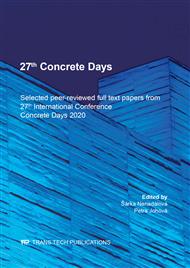p.35
p.41
p.48
p.54
p.60
p.66
p.72
p.78
p.87
Strength of AAAS Composites with Ceramic Precursor over Time
Abstract:
The paper deals with the approximation of the time evolution of the strengths of selected alkali-activated aluminosilicate (AAAS) composites based on ceramic precursors. Composites made of brick dust as a precursor and an alkaline activator with a silicate modulus of Ms = 0.8, 1.0, 1.2, 1.4, and 1.6 were investigated. The filler consisted of standard quartz sand in one case, and crushed brick in the other. The test specimens had nominal dimensions of 40 × 40 × 160 mm and were tested in three-point bending after 7, 28, 90, and 300 days of maturation. From each composite, 3 specimens were tested and the compressive strength was determined from the 6 specimen parts that remained after the bending tests. The obtained flexural and compressive strength values for the abovementioned 4 composite ages were approximated by the exponential function , where the coefficient a represents a horizontal asymptote to the approximation curve, i.e. the theoretical strength of the composite at time t = ∞; the exponential term of the approximation with the coefficients b and c expresses the degree of the time-dependent change of the respective compressive strength in the interval t = (0, ∞). The approximation was performed with the least squares method using genetic algorithms implemented in the Java GA package with open source code.
Info:
Periodical:
Pages:
60-65
Citation:
Online since:
August 2021
Authors:
Price:
Сopyright:
© 2021 Trans Tech Publications Ltd. All Rights Reserved
Share:
Citation:


